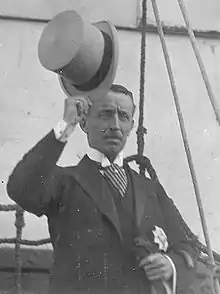Henry Galway
Lieutenant Colonel Sir Henry Lionel Galway, KCMG, DSO (25 September 1859 – 17 June 1949) was a British Army officer and the Governor of South Australia from 18 April 1914 until 30 April 1920.
Sir Henry Galway KCMG, DSO | |
|---|---|
 Sir Henry Galway in 1919 | |
| 17th Governor of South Australia | |
| In office 18 April 1914 – 30 April 1920 | |
| Monarch | George V |
| Premier | Archibald Peake (1914–15) Crawford Vaughan (1915–17) Archibald Peake (1917–20) Henry Barwell (1920) |
| Preceded by | Sir Day Bosanquet |
| Succeeded by | Sir Archibald Weigall |
| Personal details | |
| Born | 25 September 1859 |
| Died | 17 June 1949 (aged 89) |
| Nationality | British |
| Military service | |
| Allegiance | United Kingdom |
| Branch/service | British Army |
| Years of service | 1878–1902 |
| Rank | Lieutenant Colonel |
| Battles/wars | Benin Expedition of 1897 Anglo-Aro War |
| Awards | Knight Commander of the Order of St Michael and St George Distinguished Service Order Mentioned in Despatches |


Early life
Henry Lionel Gallwey was born on 25 September 1859 at Alverstoke, Hampshire, England, to Lieutenant General Thomas Lionel Gallwey and his second wife, Alicia Dorinda Lefanu, née MacDougall. He was educated at Cheltenham College.
Military career
After attending the Royal Military College, Sandhurst, Gallwey was commissioned in 1878. He served as an aide-de-camp to the governors of Bermuda, being promoted to captain in 1887.
Gallwey was appointed deputy commissioner and vice-consul in the newly established Oil Rivers Protectorate (later the Niger Coast Protectorate) in 1891. In March 1892, he failed to convince the King of Benin, Omo n’Oba Ovonramwen, into signing a deceptive 'treaty of friendship' that would make Benin a British colony. Instead, the King issued an edict barring all British officials and traders from entering Benin territories. The 'Gallwey Treaty', although it was never signed, became the legal basis for the British invasion, occupation, and looting, culminating in the Benin Expedition of 1897, which destroyed the Kingdom of Benin. Gallwey was often mentioned in despatches during this time, and was rewarded with the Distinguished Service Order (DSO; 1896), appointment as Companion of the Order of St Michael and St George (CMG; 1899) and promotion to major (1897).
Gallwey was attached as a political officer to the staff of the British Field Force during the Aro-Anglo war from November 1901 until March 1902 and was mentioned in despatches by the High Commissioner to Southern Nigeria.[1]
Given the rank of lieutenant colonel when he was placed on half-pay in 1901, Gallwey retired from the army in 1902.
Governorships
After retiring from the army, Gallwey was in November 1902 appointed as governor of the island of Saint Helena,[2] where he revived capital punishment. Appointed Knight Commander of the Order of St Michael and St George (KCMG) in 1910, he was transferred to Gambia in 1911.
Galway was appointed Governor of South Australia in 1914. He resented the limitations placed upon a constitutional governor, and his governorship was defined by controversy. He managed to anger a wide spectrum of the population. The general public disliked his support of compulsory military training; puritans were angered by his support for gambling and his opposition to prohibition; progressives were infuriated by his opposition to women's enfranchisement; and the political establishment were aghast at his opposition to the White Australia Policy (on the grounds that the Northern Territory needed Asian workers). For this last opinion, he was forced to issue a full retraction and apology. A speech in 1915 in which Galway suggested that trade unionists should be conscripted and sent to the front was widely criticised and gave local cartoonists a field day.[3]
It was eventually Galway's support for conscription that saved his governorship; the legislature decided that his efforts to increase voluntary recruitment for the First World War, as well as his support for conscription referendums, warranted keeping him in the role. A motion in the legislature by the Labor opposition in 1917 calling for the abolition of his office failed.[3]
After the war, Premier Archibald Peake was considering a proposal to build a national war memorial on the site of Government House, with a new vice-regal residence to be purchased in the suburbs. Galway managed to dissuade Peake from this scheme, and the war memorial was built in a corner of the grounds of Government House.[3]
Galway's appointment was not renewed when it expired in 1920; although he was liked by the Adelaide establishment, he had been a spectacularly controversial governor, and the Colonial Office did not give him another post. He returned to England later in 1920.
Personal life
In 1911, Gallwey changed his surname to "Galway". On 26 August 1913 in London he married Baroness Marie Carola Franciska Roselyne d'Erlanger. He died on 17 June 1949.
References
- "No. 27473". The London Gazette. 12 September 1902. pp. 5879–5886.
- "Appointment". The Times (36931). London. 21 November 1902. p. 7.
- Howell, P.A. (1981). "Galway, Sir Henry Lionel (1859–1949)". Australian Dictionary of Biography. Volume 8. Melbourne: Melbourne University Press. OCLC 897501336.
| Government offices | ||
|---|---|---|
| Preceded by Robert Armitage Sterndale |
Governor of Saint Helena 1902–1911 |
Succeeded by Harry Cordeaux |
| Preceded by George Chardin Denton |
Governor of The Gambia 1911–1914 |
Succeeded by Edward John Cameron |
| Preceded by Sir Day Bosanquet |
Governor of South Australia 1914–1920 |
Succeeded by Sir Archibald Weigall |

